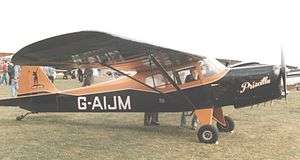Auster J/4
The Auster J/4 was a 1940s British single-engined two-seat high-wing touring monoplane built by Auster Aircraft Limited at Rearsby, Leicestershire.
| Auster J/4 | |
|---|---|
 | |
| Auster J/4 at PFA Rally held at Cranfield, Bedfordshire, in July 1989 | |
| Role | Touring aircraft |
| Manufacturer | Auster Aircraft Limited |
| First flight | 1946 |
| Number built | 27 |
| Developed from | Auster J/2 Arrow |
History
Sales in the United Kingdom of the American-engined Auster J/2 Arrow were limited by import restrictions on the engines, so Auster re-engined the aircraft with a British engine, the 90 hp Blackburn Cirrus Minor I. The first aircraft flew towards the end of 1946. The two-seat aircraft proved less popular than the companies three-seat Auster J/1 Autocrat and only 27 aircraft were built. A number of aircraft were exported to Australia and these were known as the Archer in that country.[1]
On 30 August 1955 an Australian aircraft VH-AET managed to take-off from Bankstown Airport Sydney without a pilot. It was followed out to sea by Royal Australian Navy Hawker Sea Furies and shot down.[1]
Specifications (J/4)
Data from Jane's all the World's Aircraft 1949-50[2], The Incomplete Guide to Airfoil Usage[3], British Civil Aircraft since 1919 Volume I[4]
General characteristics
- Crew: 2
- Length: 22 ft 6 in (6.86 m)
- Wingspan: 36 ft 1 in (11.0 m)
- Height: 6 ft 6 in (1.98 m) tail down, propeller horizontal
- Wing area: 185 sq ft (17.2 m2)
- Aspect ratio: 6.857
- Airfoil: NACA 23012
- Empty weight: 955 lb (433 kg)
- Gross weight: 1,600 lb (726 kg)
- Fuel capacity: Fuel:15 imp gal (18 US gal; 68 l) in fuselage fuel tank, with 13.75 imp gal (16.51 US gal; 62.5 l) under-fuselage auxiliary tank; Oil:2 imp gal (2.4 US gal; 9.1 l) aft of engine.
- Powerplant: 1 × Blackburn Cirrus Minor I 4-cylinder inverted air-cooled in-line piston engine, 90 hp (67 kW) maximum at 2,600rpm
- Propellers: 2-bladed Weybridge wooden fixed pitch propeller
Performance
- Maximum speed: 108 mph (174 km/h, 94 kn)
- Cruise speed: 92 mph (148 km/h, 80 kn) at 2,300 rpm
- Stall speed: 37 mph (60 km/h, 32 kn)
- Range: 317 mi (510 km, 275 nmi)
- Service ceiling: 12,500 ft (3,800 m)
- Rate of climb: 746 ft/min (3.79 m/s)
- Wing loading: 8.65 lb/sq ft (42.2 kg/m2)
- Fuel consumption: 0.3234 lb/mi (0.0912 kg/km)
- Power/mass: 17.1 lb/hp (10.4 kg/kW)
- Take-off run: 150 yd (140 m) in 5 mph (4.3 kn; 8.0 km/h) wind
- Landing run: 80 yd (73 m) in 5 mph (4.3 kn; 8.0 km/h) wind
References
| Wikimedia Commons has media related to Auster J/4. |
- Ellison, N.H.; MacDemitria, R.O. (1966). Auster Aircraft – Aircraft Production List. Air-Britain (Historians) Ltd. p. 55.
- Bridgman, Leonard, ed. (1949). Jane's all the World's Aircraft 1949-50. London: Sampson Low, Marston & Co. pp. 20c–21c.
- Selig, M. "The Incomplete Guide to Airfoil Usage". m-selig.ae.illinois.edu. Retrieved 22 November 2018.
- Jackson, A. J. (1987). British Civil Aviation since 1919 Volume 1 (2nd with corrections ed.). London: Putnam. pp. 71–74. ISBN 978-0-370-10006-7.